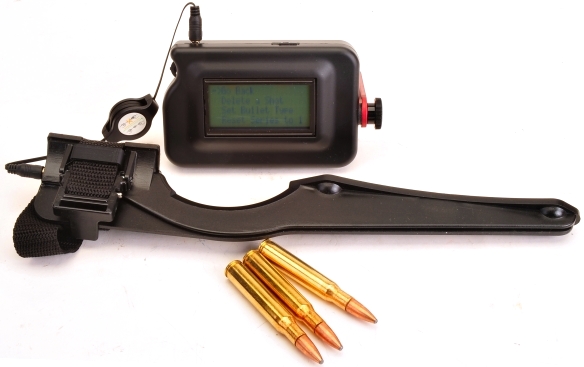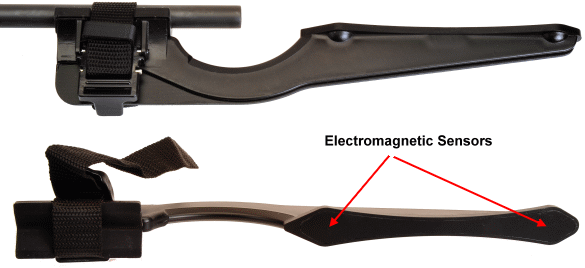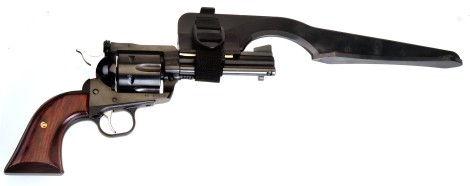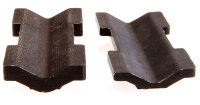
The concept of a chronograph is tough to improve upon but, this time, I think the folks at MagnetoSpeed did just that. The MagnetoSpeed overcomes some of the most significant limitations and irritations associated with the use of a traditional chronograph. The MagnetoSpeed is complete as pictured above. It has no requirement for visible or non-visible spectrum light to function. It does not mount on a tripod, it has no framed sky screens or diffusers and a shooter never has to cross a firing line to set up. The complete unit, monitor and sensor pad, weighs 12 ounces and works with rifles, fixed barrel handguns and shotguns. Really.
At the heart of the matter… The Bayo Unit
The MagnetoSpeed utilizes electromagnetic sensors, rather than optical sensors, to detect the presence of a bullet, so light plays no role in the MagnetoSpeed’s function. Because the sensors are reading mass disrupting a magnetic field, rather than the magnetic properties of a bullet, bullets can be made of magnetic or non-magnetic material; solid copper, copper or steel jacketed or lead.

The component shown above is called the Bayo Unit. This takes the place of a traditional chronograph’s remote electronics, tripod, framed screens and diffusers. As shown, it mounts directly to a firearm’s barrel and is secured with a nylon muzzle strap that is tightly cinched with a quick release Clickcam. MagnetoSpeed indicates the Bayo is designed to fit barrels with a muzzle diameter between 0.50″ and 1.00″. The rifle in this case is a Remington M700 Mountain Rifle with what would be considered a pencil thin barrel and it measures 0.55″ at the muzzle. In the course of evaluating the MagnetoSpeed, it was also used on 1″ muzzle target rifles and banded front sight firearms without any problems.
Everything else…
Other than the Bayo, the MagnetoSpeed chronograph has a display unit and a data cable to connect the two. Pictured below, the approximately 4⅝”x3″x1″ 7 ounce unit can sit on a bench, or clip on a belt or pocket by moving the Clipstand to one of three positions. The data cable is 4″ long when retracted and 32″ long when extended for flexibility in placing the display. The unit is small but, like today’s smart phones, it has a menu driven software system with lots of applicable features and functionality.

How meaningful is this product component packaging? The MagnetoSpeed is secured to the end of a gun’s barrel and the display sits on the bench or clips to a belt or pocket. My Oehler box needs a laptop computer to function and utilizes three sky screens mounted to a 4′ steel bar supported by two heavy duty tripods. My Shooting Chrony transports small, but in use requires two wire frames and sensor diffusers and a tripod to support the sensor unit. When the sky becomes overcast, common with Maine’s rainy weather or gray winters, neither the Oehler or Chrony works and I can’t use either indoors without the purchase of expensive infrared light sensitive screens. Additionally, when I bring either to a public range I have to haul all of the pieces to a shooting bench, get permission to set up on the downrange side of the firing line. If I don’t get set up correctly on the first pass, I have to wait for a cease fire to try again.
Easy to use and extensive features…
The Bayonet is secured to the barrel, one end of the mini jack data cable is plugged into the Bayo, the other into the Display, and the chronograph is ready to record velocity. In this configuration the unit will display velocity for each shot within a string, then Max, Min, Average, and Standard Deviation. Data can be recorded in a Micro SD card and played back on the display or transferred to a PC for further analysis by selecting “Archive” on the display’s menu.
There are a number of shooter selectable options. Data can be displayed in feet per second or meters per second. Readings can be optimized for accuracy by selecting a bullet type based on the bullet’s magnetic properties: Copper Lead Core (Default), Copper Steel Core and Shot/Slug. For those who like to play with non-standard projectiles… and you know who you are, you can also set a custom trigger based on onscreen menu guided instructions. The unit can be set to provide a backlit or non-backlit display. The chronograph is powered by 4 AA batteries and “Off” makes batteries last longer. Shot strings can be managed: started or stopped, single shots cleared and new strings started.
Creative approaches to Bayo mounting

The use of the Bayo determines the use of the chronograph. If you can find a stationary position on a barrel that is 2.5″ long that begins 3.0″ to 5″ from the gun’s muzzle, and is between 0.5″ and 1.0″ in diameter, you can mount the MagnetoSpeed to it and measure velocity. Which looks something like this:

The Bayo does not have to be positioned at 6 o’clock to function, it just needs to be parallel to the bore with the bullet passing approximately 0.250″ above the sensors. Our test mule Ruger No.1 45-70 that is wired for pressure and sound level testing easily mounted the Bayo aft of the front sight band and the curvature of the Bayo’s blast area cleared the sight.

A similar treatment for a tubular magazine saddle carbine and a Blackhawk 41 Magnum.

We side mounted the GP100 so that the Bayo could be mounted in line with the front sight, which kept the data cable jack away from cylinder gap gas and we could open and load the cylinder.


 Above, the Bayo mounted on a pencil thin mountain rifle barrel… remember them? The MagnetoSpeed’s nylon strap pulls a gun against the Bayo’s V block. The use of rubber V block pads of differing thicknesses moves the sensor closer or farther away from a gun’s bore axis. I’ve also fabricated pads of varying thickness from material like cardstock or plastic shim stock.
Above, the Bayo mounted on a pencil thin mountain rifle barrel… remember them? The MagnetoSpeed’s nylon strap pulls a gun against the Bayo’s V block. The use of rubber V block pads of differing thicknesses moves the sensor closer or farther away from a gun’s bore axis. I’ve also fabricated pads of varying thickness from material like cardstock or plastic shim stock.
Comparative readings – MagnetoSpeed Vs optical sensor chronograph…
It seemed the most accurate way to see how readings from the Magneto speed compared to a more conventional chronograph was to shoot through both concurrently so that both were clocking the same projectile. Since most conventional chronographs are placed ten feet from the muzzle of a firearm, we installed the MagnetoSpeed on each firearm and shot through a three sky screen Oehler chronograph. Firearm bore and both chronographs were level to a parallel plane.
| Cartridge | Bullet Type* |
Bullet Type Threshold |
Bullet Weight |
MagnetoSpeed Velocity |
Oehler Velocity |
MagnetoSpeed +Over/-Under |
| 45-70 Gov’t | CJLC | Default 14 | 300 | 1691 | 1698 | -7 |
| 45-70 Gov’t | Lead | Default 14 | 405 | 1228 | 1229 | -1 |
| 45-70 Gov’t | Copper | Default 14 | 250 | 2131 | 2133 | -2 |
| 45-70 Gov’t | SJLC | Default 14 | 500 | 1794 | 1801 | -7 |
| 41 Magnum | CJLC | Default 14 | 210 | 1430 | 1432 | -2 |
| 41 Magnum | Lead | Default 14 | 265 | 1283 | 1286 | -3 |
| 30-30 WCF | CJLC | Default 14 | 170 | 2016 | 2022 | -6 |
| 30-30 WCF | Lead | Default 14 | 170 | 2165 | 2172 | -7 |
| 357 Magnum | CJLC | Default 14 | 158 | 1238 | 1241 | -3 |
| 22 LR | Lead | Custom 6 | 40 | 1294 | 1307 | -13 |
| *CJLC = Copper Jacket Lead Core SJLC = Steel Jacket Lead Core Lead = Hard Cast, No Gas Check Copper = Solid Copper |
||||||
The MagnetoSpeed did a good job. I’ve run this type of comparison between the Oehler and a Shooting Chrony in the past by placing the Chrony ten feet from the gun’s muzzle setting the Oehler software to reflect the Oehler screens distance behind the Chrony. The difference was typically in the twenty to thirty fps range. Keep in mind that only a one percent deviation can be created on any chronograph by shifting bullet path out of parallel with sensor surfaces or changing the distance between a gun’s muzzle and a chronograph’s first sensor without compensating in chronograph software settings.
Initially, the 22 LR velocity was not picked up. I changed the bullet type to a custom setting, following the MagnetoSpeed’s prompts; non-magnetic bullet, level crossing trigger and threshold to #6. Velocity read within 13 fps of the Oehler and I am sure I could have tuned this closer by dropping the threshold setting down a bit, but I just didn’t have the time to experiment more.
| Cartridge | Bullet Type* |
Bullet Type Threshold |
Bullet Weight |
MagnetoSpeed Velocity |
Oehler Velocity |
MagnetoSpeed +Over/-Under |
| 45-70 Gov’t | Lead | Default14 | 405 | 1250 | 1254 | -4 |
| 45-70 Gov’t | Lead | Steel 7 | 405 | 1234 | 1252 | -18 |
| 45-70 Gov’t | Lead | Shot/Slug 2 | 405 | 1250 | 1251 | -1 |
| *CJLC = Copper Jacket Lead Core SJLC = Steel Jacket Lead Core Lead = Hard Cast, No Gas Check Copper = Solid Copper |
||||||
Table above – I know this is a surprise, but sometimes we don’t all follow instructions or we just flat get it wrong, so I shot a few rounds changing the bullet type settings to something blatantly incorrect. Even here the changes in fps readings fall into the category of finesse, not major. I am not suggesting any of this is a scientific analysis or evaluation of the MagnetoSpeed; more of an carefully conducted experienced shooter’s assessment.
Conclusions
The MagnetoSpeed chronograph is not a solution for 100% of the shooters out there, but perhaps for 90%… or 100% of the time for 90% of a shooters applications. Long guns, fixed barrel handguns, shotguns, muzzle loaders are all viable subject firearms. Folks shooting slide over barrel autoloaders and very short barrel handguns will still need to look to tripod mounted chronographs for now. For that 90%, the MagnetoSpeed overcomes many of the limitations and obstacles associated with optical sensor chronographs: no requirement for ambient light, compact and light weight, setup behind the firing line.
In comparison to the preproduction unit we looked at several months ago, the folks at MagnetoSpeed have really refined the product; appearance, function, mechanical consideration into a quality consumer product. Bullet type limitations have all been overcome, straps and clips are majorly improved, readings track consistently close to readings from good optical chronographs and there are facilities within the software for fine tuning if desired. With a $250 MSRP, the ready to use unit is competitively priced and I suspect they will sell like jelly beans.
Things I’d like to see? Ya’ know, there is always something for me to whine about. The data cable is 32″ long, less than the length of many long guns, so I would like to see something longer packaged with the MagnetoSpeed. They are standard 3.5mm audio cables like those used with smart phones and iPods and they cost less than a couple of bucks in length over 48″ even on Amazon. At some future time I’d like to see a “U” slot pivot securing the Bayo to the V block. This would allow the user to set the distance from the sensor deck to a gun’s bore and pivot it to assure both are in parallel without changing V block pads or shimming. That’s it, and I am being picky. Nice product,MagnetoSpeed.

Email Notification